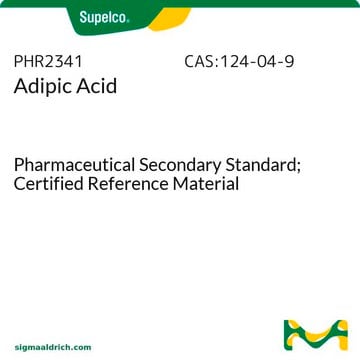W201103
Adipic acid
≥99.5%
Sinonimo/i:
Hexanedioic acid
About This Item
Prodotti consigliati
Origine biologica
synthetic
Conformità normativa
FDA 21 CFR 117
Densità del vapore
5 (vs air)
Tensione di vapore
1 mmHg ( 159.5 °C)
Saggio
≥99.5%
Temp. autoaccensione
788 °F
P. ebollizione
265 °C/100 mmHg (lit.)
Punto di fusione
151-154 °C (lit.)
Solubilità
H2O: soluble 23 g/L at 25 °C
applicazioni
flavors and fragrances
Documentazione
see Safety & Documentation for available documents
Allergene alimentare
no known allergens
Organolettico
odorless
Stringa SMILE
OC(=O)CCCCC(O)=O
InChI
1S/C6H10O4/c7-5(8)3-1-2-4-6(9)10/h1-4H2,(H,7,8)(H,9,10)
WNLRTRBMVRJNCN-UHFFFAOYSA-N
Cerchi prodotti simili? Visita Guida al confronto tra prodotti
Avvertenze
Danger
Indicazioni di pericolo
Consigli di prudenza
Classi di pericolo
Eye Dam. 1
Codice della classe di stoccaggio
11 - Combustible Solids
Classe di pericolosità dell'acqua (WGK)
WGK 1
Punto d’infiammabilità (°F)
384.8 °F - closed cup
Punto d’infiammabilità (°C)
196 °C - closed cup
Dispositivi di protezione individuale
dust mask type N95 (US), Eyeshields, Gloves
Scegli una delle versioni più recenti:
Possiedi già questo prodotto?
I documenti relativi ai prodotti acquistati recentemente sono disponibili nell’Archivio dei documenti.
I clienti hanno visto anche
Il team dei nostri ricercatori vanta grande esperienza in tutte le aree della ricerca quali Life Science, scienza dei materiali, sintesi chimica, cromatografia, discipline analitiche, ecc..
Contatta l'Assistenza Tecnica.












